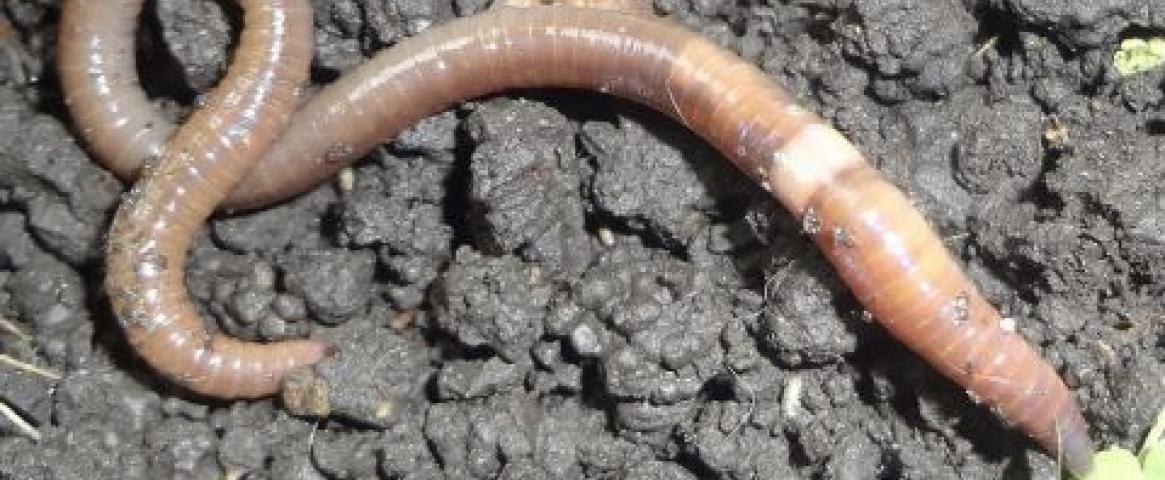By Megan Reich
In the 11,000 years since the glaciers retreated from the Great Lakes region, Minnesota hardwood forests developed in the absence of earthworms. These forests instead evolved to rely on bacteria and fungi to breakdown leaf litter into accessible nutrients for the maples, oaks, and shade-loving spring ephemerals that populate the forests. This dynamic gives the Minnesota forests their characteristic soft and spongy forest floor.
“It’s like walking on a memory foam mattress,” says Lee Frelich, University of Minnesota forest ecology professor and lead researcher of the Jumping Worms Project. “The leaf litter is that thick.”
But now, the invasive jumping worm is posing a threat to this ecosystem, disintegrating the forest floor’s layer of leaf litter and triggering soil erosion. As the jumping worm spreads through the state, Frelich is on a mission to understand what management practices might be effective for limiting the worm’s impacts.
Jumping worms (Amynthas species), native to East Asia, are named for the way they writhe about when disturbed. While it’s unclear how they arrive, people began spreading jumping worms throughout North America via potting soil, mulch, compost, and fishing bait. Jumping worms transform the soil in ways even more drastic than their European counterparts, which invaded Minnesota soils when European settlers arrived.
“As jumping worms eat the soil and excrete it, you get these little balls with a coffee-ground texture,” says Frelich. The granular, loose quality of jumping worm-infested soil makes it harder for smaller plants to successfully establish.
Unlike European earthworms, jumping worms live in the top few inches of the forest soil. The transformation of this section of the soil is devastating for larger trees, too, Frelich explains, because almost all the trees’ fine nutrient-absorbing fine roots are in the top 18 inches of soil. When jumping worms eat these fine root hairs, tree growth slows down.
Additionally, jumping worm-infested soil does not easily clump together, which means it erodes faster. In heavy rain the soil gets washed away, taking essential nutrients like nitrogen, phosphorus, and calcium with it. According to a 2019 review in Frontiers in Ecology and the Environment, co-authored by Frelich, this disturbance can trigger a range of cascading ecological effects, including decreased forest productivity, changes in plant and animal communities, and facilitation of other invasive species like buckthorn. Buckthorn causes further harm to forests by crowding out native plants and displacing smaller trees where many bird species nest.
After receiving project funding in 2019, the Jumping Worm Project’s first objective was figuring out how jumping worms spread. After mapping jumping worm presence in garden beds on the University of Minnesota Twin Cities campuses and at the Minnesota Landscape Arboretum, Frelich’s team suspects they mostly spread through mulch. Worms can propagate via mulch when it is not heat treated, a practice that is standard for commercial mulch suppliers.
Knowing where jumping worms have already spread throughout the state will be also be an important step in managing them. The Jumping Worms Project is currently asking volunteers to take pictures of suspected jumping worms they find and submit these photos to the web-based mapping system EDDMapS. Once Frelich verifies the picture, it becomes an official report with a geographic coordinate. Volunteers can submit data on their own time or through organized surveys that take place at various host sites throughout the state.
According to Laura Van Riper, terrestrial invasive species coordinator with the Minnesota Department of Natural Resources, most confirmed EDDMapS reports are concentrated in Southeast Minnesota, especially in Rochester and the Twin Cities. “It is much less resource-intensive to prevent something from coming in than to try and deal with it once its arrived,” Van Riper says. She emphasizes that it will be important to develop prevention and management strategies before the worms spread northward, where the majority of hardwood forests remain in Minnesota.
Frelich’s team will be attempting to address this by testing the effectiveness of several management techniques. On small jumping worm-infested plots within the Minnesota Arboretum, the team will be applying different forest-friendly chemicals, including saponins, sulfur, and biochar, or charcoal. “I don’t think we’re going to find anything that will work on the scale of the whole forest,” Frelich admits. “But for gardeners in urban areas with small garden areas, I think we will end up knowing how to control them.”
Megan Reich is a freelance writer and a graduate student in Johns Hopkins University’s MA in Science Writing Program. You can follow her work at meganreich.net or email her at megan@reichweb.com.
This story was produced as part of NASW's David Perlman Summer Mentoring Program, which was launched in 2020 by our Education Committee. Reich was mentored by Monique Brouillette.
Main image: Jumping worms look similar to other non-native earthworms in Minnesota, such as nightcrawlers and angle worms. By the time they mature in late July, they develop their characteristically cloudy-white clitellum, a small ring about 1/3 down from their head. Credit: Flickr, Alfredo Eloisa/CC BY-NC-SA 2.0

